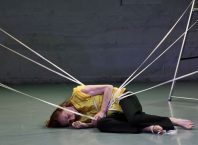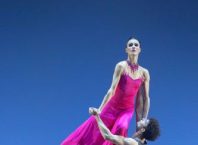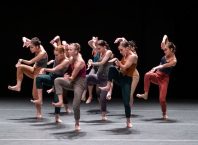Avi Kaiser and Sergio Antonino take dance off the stage and into a more intimate place with their site-specific performance At Your Place. I had the pleasure of talking to Avi about the dancer/choreographers’ ongoing project, in anticipation of its performance at the Suzanne Dellal Centre in the context of Tel Aviv Dance 2013. Unlike conventional concert dance performances, this one will not take place in one of the centre’s performance halls, but rather in the dance studio.

Bringing Dance Closer to the Audience – Literally
“It’s a project that had different starting points,” Avi Kaiser explained, “after a long time as performers/creators/choreographers, believing in dance as a form of expression, there was an urge to have the public understand and receive dance as a language.”
Kaiser expressed a feeling often shared by choreographers that many people these days are just not ‘into’ contemporary dance, saying, “they may have ideas about it but didn’t have the chance to experience it. I’m not always convinced they share choreographer’s experience.”
To bring audiences closer to the experience, co-creators Kaiser and Antonino sought to “abolish the classical separation between people who look and people who do” and create a performance in which the performers and public share the same space, a “common space with no border, the same ground, same conditions, both (performers and public) occupied with a very concentrated and powerful action.”
The first performances of At Your Place, took place quite literally in people’s homes. “We wanted to avoid the classical structure of theatres – frontal (performance), dark space, dancers elevated, different light…it began with the wish to oblige the people to be very present with their concentration and look. In these performances a private look becomes a collective look, (in addition to looking at the dancers) people also look at other people and see what is going on with them. Our set is the people.”
“Having the audience so close is a big challenge,” Kaiser acknowledged, “at first it was very hard. We dance exposed, we have nowhere to hide [no backstage], every breath is heard and felt. The audience’s interest or lack of interest… we see everything. It’s as if we are sitting in a cafe looking at one another.”
Dancing Close Enough to Touch
Creating and performing this work led Kaiser and Antonino to change their own perspective on performing. Kaiser explained that dancers are trained “to radiate out, to be in a big space, it’s the ABCs of dance. Suddenly we are in a small space, suddenly there is nothing to radiate.”
This new context creates a different dance experience, one that Kaiser compares to visiting a library or gallery, saying, “You go into the library and browse you start to read…you take a dancer and begin to turn the pages, or like at an exhibition, to stop in front of a painting or sculpture that particularly speaks to you with the desire to touch, to feel the material. The sense of touch is essential to dance. The feel of the air, your own body, touching one another… for me to touch is to dance. You feel at your fingertips, try (as a dancer) to develop that feeling through the whole body, view dance as an exhibition … people can almost touch it.”
What does Site-Specific Mean?
At Your Place has been performed in many alternative venues worldwide, including Duisberg, Tel Aviv, Jerusalem, Haifa, Bologna, Milano, Firenze, Madrid, New York and many more cities, yet the site-specific performance is unique to each venue. What does this mean?
“It is entirely a composed performance,” Kaiser explained, “with islands of improvisation. The composition changes radically in each space. If there is a red painting behind us or a crystal vase the whole dance changes. Every apartment is a universe of its own. With time, the most meaningful element for us is the audience; the people are the site-specific element. The real meaning of the performance is the audience who watches us, the presence of the people. It changes: depending on whether it is six in the evening or midnight, if people come hungry or full, tense or relaxed. It changes our energy.”
“In Suzanne Dellal we will be performing in the studio,” said Kaiser, “level on the floor, with open windows. It’s a place where things are in process. People will sit in chairs and on the floor. They decide where they will sit (as distinct from assigned seats in a theatre). It’s a very small space.”
“The performance never repeats itself twice,” said Kaiser, “Last summer we performed in Jerusalem in the Midrachov. It was our first time on the street. It was one of the most beautiful things that happened to us. Suddenly to begin to dance – to take that same art and dance in the street, without walls. People do not plan to come, they walk by with their bags of groceries and stop to look. People see a movement that comes to them without warning…apparently there is enough power in the movement itself to tell the person…the movement blooms in the air there is no echo. How much power, how much volume do you need so that someone will hear it?”
Kaiser says that working on and performing At Your Place, “has changed our other productions. We have totally abolished frontal looking.”
Regarding At Your Place, as it will be performed in Studio A at Suzanne Dellal, Kaiser said, “Where they sit is really one point of view, another person would see another performance. There is not one ‘point of view’. Yet everybody could share a moment of intimacy, or more likely share a common sensation. It’s like four people around a dinner table, you can see someone’s eyes across a room… I think this is the beauty of performance that we don’t see it in the same way. It’s something live. It’s like a field of flowers and we don’t step on the flowers, we dance between them. The flowers are the scenery.”
At Your Place, choreography and performance by Avi Kaiser and Sergio Antonino, a production of the Kaiser Antonio Dance Ensemble. Performances: May 17 at 22:00, May 18 at 20:00; Suzanne Dellal Centre, Studio A. Tickets may be purchased online, or call: 03-5105656.






[…] Erdos, Sigal Ziv, Dafi Altebeb, Asher Lev, Ella Ben Aharon and Edo Cedar, Maya Levy, Talia Beck, Avi Kaiser and Sergio Antonino, Osnat Kelner, Oded Tzuk, Oded Ronen, Ido Tadmor, Rina Shenfeld, Michal Herman, Alice Dor Cohen, […]
Comments are closed.